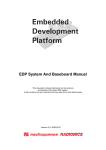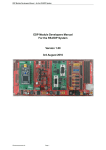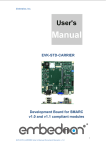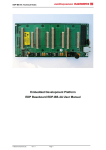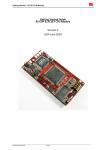Download mbed `Command Module` – Adapter Board RS-EDP-CM
Transcript
mbed ‘Command Module’ – Adapter Board RS‐EDP‐CM‐mbed User Manual Version 1.02 © Electrocomponents plc Page 1 Contents 1. Introduction 3 2. 2.1 2.2 2.3 2.4 2.5 Pin Mapping 3 MCU Pin Allocation........................................................................ 3 Backplane Resources Used by the MCU....................................... 5 Alphabetical Listing the I/O Pins .................................................... 6 Backplane Signal Names and Connections ................................... 7 Mapping Aid................................................................................. 11 3. Solder Link Options 12 4. Zero Ohm Links 16 5. Software Support 16 © Electrocomponents plc Page 2 1. Introduction The mbed development module is a very useful board that introduces a new way to write embedded firmware. Instead of having a C compiler license installed upon your machine the mbed unit makes use of a C Compiler installed on a virtual host. Your software and project are built within the framework of an HTML page. The compilation is done remotely on your behalf, and the resulting binary image file is transferred to you and stored on the mbed module. By rebooting the mbed module the new image is flashed into the hardware and the mbed module runs your application code. This is a superb way of gaining access to complex MCU’s like NXP’s ARM7 based devices without the requirement to purchase a full blown C compiler and debug tool. The mbed allows for writing of code, compiling of code and downloading to the target via very simple USB interface. The mbed platform comes currently as a 40 pin DIP module and software drivers for most of the hardware on the chip. This RS‐EDP‐CM‐mbed adapter module is designed to remap the pin out of the mbed module to that of the RS‐EDP platform. The adapter module also includes a mini SD Card interface and an SPI serial connection for a small graphics LCD. The RS‐EDP platform is a system, which has been designed to utilise many different manufacturers’ microprocessors. To support ARMs mbed module, the RS‐EDP platform uses an adapter board to connect between the RS‐EDP baseboard and the mbed module. This is referred to as the EDP‐CM‐ mbed module. The adapter module comes complete with a list of low level drivers that allow it to talk to the other module that form the RS‐EDP system. The applications modules that are currently supported include analogue module, digital I/O module, communications module, brushed DC motor drive module MC1. A set of jumper and link options provide the user with several different ways to map the mbed to the RS‐EDP. In an RS‐EDP system there is usually one Command Module (CM) and one or more Applications Modules (AM) pluged in to the Base Board (BB). This adapter board is designed to hold the mbed module and as such it will be the ‘Command module’ for the system. The ‘Command Module’ in a system dictates whether the whole system is a 3.3V one or a 5.0V one. The module uses a 3.3V microprocessor and consequently the I/O is mostly 3.3V. To tell the rest of the system the mbed module is a 3.3V Command Module and not a 5.0V Command Module, the Vcc_CM line on the base board is connected to 3.3V by the tracking on the adapter board. This Vcc_CM is used as a reference by the other modules, such as the analogue module, to limit the output voltage to 3.3V. The command voltage line is also used by the #RESET circuit. The RS‐EDP‐CM‐mbed daughter board remaps the I/O of the mbed module on to the backplane of the RS‐EDP system. As there are quite a few dual function pins on the mbed module several link options have been made to accommodate the various options. Extensive use of the I2C capability is used to communicate to the application modules in the system. 2. Pin Mapping 2.1 MCU Pin Allocation mbed Pin 1 2 3 Pin Name GND/0V VIN/4.5V‐9.0V VB © Electrocomponents plc Comment Analogue & Digital Ground 5V in from base board Battery backup ‐ 2 options Page 3 RS‐EDP Name SGND 5.0V 3V BAT Battery backup ‐ 2 options 3.3V 4 5 nR RESET input #RESIN p5/SPI11 mosi 2 link options CNTRL_SPI_MRST 2 link options EVG10_GPIO58 6 p6/SPI1 miso 2 link options CNTRL_SPI_MRST 2 link options EVG9_GPIO57 7 p7/SPI1 sck 2 link options CNTRL_SPI_CLK 2 link options EVG8_GPIO56 8 p8 3 link options CNTRL_SPI_#CS_NSS 3 link options local CS for LCD 3 link options EVG7_GPIO54 9 p9/Serial1 Tx/I2C1 sda CNTRL_I2C_SDA 10 p10/Serial1 Rx/I2C1 scl CNTRL_I2C_SCL 11 p11/SPI2 mosi 2 link options GPIO12_MCI_CMD 2 link options EVM2_GPIO41_CAPADC 12 p12/SPI2 miso 2 link options GPIO2_MCI_DAT0 2 link options EVM3_GPIO43 13 p13/Serial2 Tx 2 link options GPIO10_MCI_CLK 2 link options ASC1_TX_TTL 14 p14/Serial2 Rx 2 link options GPIO8_MCI_DAT3 2 link options local CS/SD for sd card 2 link options ASC1_RX_TTL 15 p15/AnalogueIn0 2 link options AN0 2 link options EVM0_GPIO21 16 p16/AnalogueIn1 3 link options AN1 3 link options AN10 p17/AnalogueIn2/AnalogOut1 p18/AnalogueIn3/AnalogOut1 p19/AnalogueIn4 p20/AnalogueIn5 p21/PWMOut5 p22/PWMOut4 p23/PWMOut3 p24/PWMOut2 p25/PWMOut1 p26/PWMOut0 p27/I2C2 scl/Serial3 Rx p28/I2C2 sda/Serial3 Tx p29/CAN td p30/CAN rd USB d+ 3 link options 2 link options 2 link options 3 link options 3 link options 3 link options 2 link options 2 link options 2 link options 2 link options 2 link options 2 link options 2 link options 2 link options 2 link options 2 link options 2 link options 2 link options 3 link options 3 link options 3 link options 3 link options 3 link options 3 link options 2 link options 2 link options 2 link options 2 link options 2 link options 2 link options 2 link options 2 link options EVM1_GPIO23 AN2 IRQ_GPIO16_CNTRL_I2C_INT AN3 AN12 CPU_DACO0_GPIO17 AN4 GPIO0 AN5 ASC1_RX_TTL_ASC0_DSR CPU_DACO0_GPIO17 MOTORP0L CPU_DACO1_GPIO19 MOTORP1L EVG0_GPIO40 MOTORP2L EVG1_GPIO42 MOTORP0H EVG2_GPIO44 ASC1_RX_TTL MOTORP1H EVG3_GPIO46 ASC1_TX_TTL MOTORP2H ASC0_RX_TTL EVG4_GPIO48 ASC0_TX_TTL EVG3_GPIO46 EVG5_GPIO50 CAN0_TX EVG6_GPIO52 CAN0_RX USB_DEV_D+ 17 18 19 20 21 22 23 24 25 26 27 28 29 30 31 © Electrocomponents plc Page 4 32 33 34 35 36 37 38 39 40 USB d‐ Ethernet TD+ Ethernet TD‐ Ethernet RD+ Ethernet RD‐ IF+ IF‐ VU/5.0V USB Out VOUT/3.3V Reg Out USB_HOST_D‐ ETH_TX+ ETH_TX‐ ETH_RX+ ETH_RX‐ USB_DEBUG_D+ USB_DEBUG_D‐ not connected local power on led 2.2 Backplane Resources Used by the MCU Resources Used/Available #RESIN 3.3V 3V BAT 5.0V AN0 AN1 AN2 AN3 AN4 AN5 AN10 AN12 ASC0_RX_TTL ASC0_TX_TTL ASC1_RX_TTL ASC1_RX_TTL ASC1_RX_TTL_ASC0_DSR ASC1_TX_TTL ASC1_TX_TTL CAN0_RX CAN0_TX CNTRL_I2C_SCL CNTRL_I2C_SDA CNTRL_SPI_#CS_NSS CNTRL_SPI_CLK CNTRL_SPI_MRST CNTRL_SPI_MRST CPU_DACO0_GPIO17 CPU_DACO1_GPIO19 ETH_RX‐ ETH_RX+ ETH_TX‐ ETH_TX+ EVG0_GPIO40 EVG1_GPIO42 EVG2_GPIO44 EVG3_GPIO46 EVG3_GPIO46 EVG4_GPIO48 EVG5_GPIO50 EVG6_GPIO52 EVG7_GPIO54 EVG8_GPIO56 EVG9_GPIO57 © Electrocomponents plc Page 5 EVG10_GPIO58 EVM0_GPIO21 EVM1_GPIO23 EVM2_GPIO41_CAPADC EVM3_GPIO43 GPIO0 GPIO2_MCI_DAT0 GPIO8_MCI_DAT3 GPIO10_MCI_CLK GPIO12_MCI_CMD IRQ_GPIO16_CNTRL_I2C_INT MOTORP0H MOTORP0L MOTORP1H MOTORP1L MOTORP2H MOTORP2L SGND USB_DEBUG_D‐ USB_DEBUG_D+ USB_DEV_D+ USB_HOST_D‐ 2.3 Alphabetical Listing the I/O Pins Alphabetical Listing of IO 36 Ethernet RD‐ 35 Ethernet RD+ 34 Ethernet TD‐ 33 Ethernet TD+ 1 GND/0V 38 IF‐ 37 IF+ 4 5 nR 6 p6/SPI1 miso 7 p7/SPI1 sck 8 p8 9 p9/Serial1 Tx/I2C1 sda 10 p10/Serial1 Rx/I2C1 scl 11 p11/SPI2 mosi 12 p12/SPI2 miso 13 p13/Serial2 Tx 14 p14/Serial2 Rx 15 p15/AnalogueIn0 16 p16/AnalogueIn1 17 p17/AnalogueIn2/AnalogOut1 18 p18/AnalogueIn3/AnalogOut1 19 p19/AnalogueIn4 20 p20/AnalogueIn5 21 p21/PWMOut5 22 p22/PWMOut4 23 p23/PWMOut3 24 p24/PWMOut2 25 p25/PWMOut1 26 p26/PWMOut0 p27/I2C2 scl/Serial3 Rx p29/CAN td 27 29 p5/SPI11 mosi © Electrocomponents plc Page 6 28 30 32 31 3 2 40 39 p28/I2C2 sda/Serial3 Tx p30/CAN rd USB d‐ USB d+ VB VIN/4.5V‐9.0V VOUT/3.3V Reg Out VU/5.0V USB Out 2.4 Backplane Signal Names and Connections Base Board Signal Name #CS0 #CS1 #CS2 #CS3 #PSEN #RD #RESIN #RESOUT #WR #WRH 12V 12V 12V 12V 12V GND 12V GND 12V GND 12V GND 3.3V 3.3V 3.3V 3V BAT 5.0V 5.0V 5.0V A0_AD0 A1_AD1 A2_AD2 A3_AD3 A4_AD4 A5_AD5 A6_AD6 A7_AD7 A8_AD8 A9_AD9 A10_AD10 A11_AD11 A12_AD12 A13_AD13 A14_AD14 A15_AD15 ALE AN_REF AN0 AN1 AN2 AN3 AN4 © Electrocomponents plc EDPCON1 133 134 135 136 137 138 139 140 127 128 124 129 130 1 3 4 5 6 7 EDPCON2 53 & 54 55 & 56 57 & 58 59 & 60 51 & 52 45 & 46 1 & 2 3 & 4 47 & 48 49 & 50 95 & 96 97 & 98 41 & 42 39 & 40 37 & 38 35 & 36 33 & 34 31 & 32 29 & 30 27 & 28 25 & 26 23 & 24 21 & 22 19 & 20 17 & 18 15 & 16 13 & 14 11 & 12 43 & 44 Break Out Connector P603 P603 P603 P603 P603 P603 P603 P603 P603 P603 P603 P603 P603 P603 P603 P603 P603 P601 P603 P603 P603 P603 P602 Page 7 26 27 47 47 47 47 48 48 48 48 44 44 44 42 45 45 45 6 2 6 1 5 2 AN5 AN6 AN7 AN8 AN9 AN10 AN11 AN12 AN13 AN14 AN15 ASC0_RX_TTL ASC0_TX_TTL ASC1_RX_TTL ASC1_RX_TTL_ASC0_DSR ASC1_TX_TTL ASC1_TX_TTL_ASC0_DTR CAN0_RX CAN0_TX CAN1_RX CAN1_TX CANH0 CANL0 CNTRL_I2C_SCL CNTRL_I2C_SDA CNTRL_SPI_#CS_NSS CNTRL_SPI_CLK CNTRL_SPI_MRST CNTRL_SPI_MTSR CPU_DACO0_GPIO17 CPU_DACO1_GPIO19 EMG_TRAP ETH_LNK_LED ETH_RX‐ ETH_RX_LED ETH_RX+ ETH_SPD_LED ETH_TX‐ ETH_TX+ EVG0_GPIO40 EVG1_GPIO42 EVG2_GPIO44 EVG3_GPIO46 EVG4_GPIO48 EVG5_GPIO50 EVG6_GPIO52 EVG7_GPIO54 EVG8_GPIO56 EVG9_GPIO57 EVG10_GPIO58 EVG11_GPIO59 EVG12_GPIO60 EVG13_GPIO61 EVG14_GPIO62 EVG15_GPIO63 EVG16_GPIO64 EVG17_GPIO65 EVG18_GPIO66 EVG19_GPIO67 EVG20_GPIO69_ASCO_RTS EVM0_GPIO21 © Electrocomponents plc 8 9 10 11 12 13 14 15 16 17 18 89 91 93 99 95 97 121 123 38 40 114 111 109 113 107 115 105 103 61 63 65 67 69 71 73 75 77 78 79 80 81 82 83 84 85 86 87 88 92 42 61 & 62 63 &64 89 & 90 91 & 92 79 & 80 77 & 78 75 & 76 69 & 70 71 & 72 73 & 74 P602 P602 P602 P601 P601 P601 P601 P603 P602 P603 P602 P602 P602 P602 P602 P602 P602 P602 P602 P603 P603 P603 P603 P603 P603 P603 P603 P603 P601 P601 P602 P602 P602 P602 P602 P602 P602 P602 P602 P602 P602 P602 P602 P602 P602 P602 P601 P602 P601 P602 P601 P602 P601 P602 P601 P602 P601 P601 P601 Page 8 4 1 3 2 4 1 3 4 6 3 5 30 31 32 35 33 34 46 47 40 41 35 34 33 30 31 32 7 7 44 41 40 42 39 43 38 37 16 17 18 19 20 21 22 23 24 26 25 27 26 28 27 29 28 30 29 31 33 8 EVM1_GPIO23 EVM2_GPIO41_CAPADC EVM3_GPIO43 EVM4_GPIO45 EVM5_GPIO47 EVM6_GPIO49 EVM7_GPIO51 EVM8_GPIO53 EVM9_GPIO55 EVM10_GPIO68_ASCO_CTS GPIO0 GPIO1 GPIO2_MCI_DAT0 GPIO3 GPIO4_MCI_DAT1 GPIO5_I2S_TX_WS GPIO6_MCI_DAT2 GPIO7_I2S_RX_CLK GPIO8_MCI_DAT3 GPIO9_I2S_RX_WS GPIO10_MCI_CLK GPIO11_I2S_RX_SDA GPIO12_MCI_CMD GPIO13_I2S_TX_CLK GPIO14_MCI_PWR GPIO15_I2S_TX_SDA GPIO24_AD7 GPIO25_AD15 GPIO26_AD6 GPIO27_AD14 GPIO28_AD5 GPIO29_AD13 GPIO30_AD4 GPIO31_ADI2 GPIO32_AD3 GPIO33_AD11 GPIO34_AD2 GPIO35_AD10 GPIO36_AD1 GPIO37_AD9 GPIO38_AD0 GPIO39_AD8 I2C_GEN0_SCL I2C_GEN0_SDA I2C_GEN1_SCL I2C_GEN1_SDA IRQ_GPIO16_CNTRL_I2C_INT IRQ_GPIO18_I2C_GEN0_INT IRQ_GPIO20_I2C_GEN1_INT IRQ_GPIO22_I2C_INT MOTOR_TCO_FB MOTORH0_ENC0 MOTORH1_ENC1 MOTORH2_ENC2 MOTORP0H MOTORP0L MOTORP1H MOTORP1L MOTORP2H MOTORP2L MOTORPWM © Electrocomponents plc 44 62 64 66 68 70 72 74 76 90 21 22 23 24 25 26 27 28 29 30 31 32 33 34 35 36 45 46 47 48 49 50 51 52 53 54 55 56 57 58 59 60 119 117 37 39 41 43 122 116 118 120 102 100 106 104 110 108 112 7 & 8 5 & 6 P601 P601 P601 P601 P601 P601 P601 P601 P601 P601 P603 P603 P603 P603 P603 P603 P603 P603 P603 P603 P603 P603 P603 P603 P603 P602 P601 P602 P601 P602 P601 P602 P601 P602 P601 P602 P601 P602 P601 P602 P601 P603 P603 P602 P602 P603 P603 P603 P602 P601 P601 P601 P601 P601 P601 P601 P601 P601 P601 P601 Page 9 9 18 19 20 21 22 23 24 25 32 13 15 14 16 17 19 18 20 22 21 23 24 25 12 8 8 10 9 11 10 12 11 13 12 14 13 15 14 16 15 17 29 28 45 44 11 10 9 7 48 45 46 47 38 37 40 39 42 41 43 SGND SGND SGND SGND SPI_SSC_#CS_NSS SPI_SSC_CLK SPI_SSC_MRST_MISO SPI_SSC_MTSR_MOSI USB_DEBUG_D‐ USB_DEBUG_D+ USB_DEV_D‐ USB_DEV_D+ USB_HOST_D‐ USB_HOST_D+ VAGND VAGND Vcc_CM Vcc_CM Vcc_CM © Electrocomponents plc 131 132 101 98 94 96 19 20 125 126 9 & 10 99 & 100 67 & 68 65 & 66 87 & 88 85 & 86 83 & 84 81 & 82 93 & 94 P603 P603 P603 P603 P602 P601 P601 P601 P603 P603 P603 P603 P601 P601 P603 P603 P603 Page 10 46 46 46 46 36 36 34 35 39 38 37 36 5 5 43 43 43 2.5 Mapping Aid MBED – ARM Command Module to RS‐EDP Backplane J219 1 1 CNTRL_SPIMTSR EVG10_GPIO58 CNTRL_SPICLK EVG8_GPIO56 CTRL_SPI_#CS_NSS EVG7_GPIO54 Local CS_LCD GPIO_MCICMD EVM2_GPIO41_CAPADC GPIO2_MCIDAT0 EVM3_GPIO43 GPIO10_MCICLK ASCI_TX_TTL GPIO8_MCIDAT3 ASC1_RX_TTL Local CS_SD AN1 AN10 EVM0_GPIO2 1 EVM1_GPIO23 AN2 IRQ_GPIO16_CNTRL_I2CIN AN3 AN12 CPU_DACO0_GPIO17 AN4 GPIO0 AN5 ASC1_RX_TTL _ASC0DSR CNTRL I2C © Electrocomponents plc Pin 5 1 3 J206 2 Pin 6 1 3 J207 2 Pin 7 1 3 4 J208 2 Pin 8 1 3 J209 2 1 3 J210 2 Pin 12 1 3 J211 2 Pin 13 1 3 4 J212 2 Pin 14 1 3 J213 2 Pin 15 J214 2 Pin 16 J215 2 Pin 17 1 4 3 J216 2 Pin 18 1 3 J217 2 Pin 19 1 3 J218 2 3 CNTRL_SPIMRST EVG9_GPIO57 AN0 J205 2 1 4 3 1 3 Pin 21 2 Pin 22 J220 2 1 Pin 23 J221 2 1 3 Pin 24 J222 2 Pin 25 J223 2 Pin 26 J224 2 Pin 11 3 1 3 1 4 3 1 4 3 CPU_DACO0_GPIO17 MOTOR_P0L CPU_DAC01_GPIO19 MOTOR_P1L EVG0_GPIO40 MOTOR_P2L EVG1_GPIO42 MOTOR_P0H EVG2_GPIO44 ASC1_RX_TTL MOTOR_P1H EVG3_GPIO46 ASC1_TX_TTL MOTOR_P2H J225 2 1 3 EVG4_GPIO48 J226 2 1 3 EVG5_GPIO50 Pin 29 J227 2 3 1 EVM7_GPIO51 Pin 30 J228 2 3 1 EVG6_GPIO52 Pin 27 Pin 28 ASC0_RX_TTL ASC0_TX_TTL CAN0_TX CAN0_RX USBDEV+ USBDEV‐ ETH_TX_P ETH_TX_N ETH_RX_N ETH_RX_P R103 12VGND SGND R102 SGND VAGND Pin 20 Pin 9 & 10 VBAT #RESET VCC_CM Page 11 3. Solder Link Options Many of the options for the adapter/daughter board require a solder bridge to be made or a track bridge to be cut. The adapter board has been designed to be configured in the most popular setting by using track between the options, which will require cutting with a knife before making the alternate connection options. The options we have are as follows: VB – Battery Voltage – J204 The mbed module has a VB input which is a battery backup voltage supply. You can connected this to the RS‐EDP backup voltage rail or to the standard 3.3V supply via the link option. Note the base boards are supplied by default without the battery fitted. J204 – option 1‐2 Connects the VB input to the RS‐EDP 3.3V main supply (Default track connection) J204 – option 2‐3 Connects the VB input to the RS‐EDP 3.3VBAT supply on the RS‐EDP base board. DIP Pin 5 Option – J205 J205 – option 1‐2 DIP Pin 5 is connected to CNTRL_SPIMTSR (Default track connection) Use this option is you want to use it as an SPI function J205 – option 2‐3 DIP Pin5 is connected to EVG10_GPIO58 Use this option is you want to use pin 5 as a general purpose I/O line DIP Pin 6 Option – J206 J206 – option 1‐2 DIP Pin 6 is connected to CNTRL_SPIMRST (Default track connection) Use this option is you want to use it as an SPI function J206 – option 2‐3 DIP Pin6 is connected to EVG9_GPIO57 Use this option is you want to use pin 6 as a general purpose I/O line DIP Pin 7 Option – J207 J207 – option 1‐2 DIP Pin 7 is connected to CNTRL_SPICLK (Default track connection) Use this option is you want to use it as an SPI function J207 – option 2‐3 DIP Pin 7 is connected to EVG8_GPIO56 Use this option is you want to use pin 7 as a general purpose I/O line DIP Pin 8 Option – J208 This pin has three functions. It primary function is for use as the chip select pin for the CNTRL SPI. J208 – option 2‐4 DIP Pin 8 is connected to #CS_LCD (Default track connection) Use this option is you want to drive an LCD connected to the LCD SPI connector on the RS‐EDP‐CM‐mbed adapter board. J208 – option 2‐1 DIP Pin 8 is connected to CNTRL_SPI_#CD_NSS. Use this option is you want to use pin 8 as a general purpose chip select line for the CNTRL SPI. This signal is for possible use by © Electrocomponents plc Page 12 J208 – option 2‐3 DIP Pin 11 Option – J209 J209 – option 1‐2 J209 – option 2‐3 DIP Pin 12 Option – J210 J210 – option 1‐2 J210 – option 2‐3 DIP Pin 13 Option – J211 J211 – option 1‐2 J211 – option 2‐3 DIP Pin 14 Option – J212 J212 – option 2‐1 J212 – option 2‐4 J212 – option 2‐3 DIP Pin 15 Option ‐ J213 J213 – option 1‐2 J213 – option 2‐3 DIP Pin 16 Option – J214 J214 – option 2‐1 J214 – option 2‐4 J214 – option 2‐3 © Electrocomponents plc application modules within the RS‐EDP system that want to make use of the CNTRL SPI bus. DIP Pin 8 is connected to EVG7_GPIO54 Use this option if you want to use pin 8 as a general purpose I/O line DIP Pin 11 is connected to GPIO12_MCICMD(Default track connection) Use this option if you want to use it as an SPI function to talk to the SD Card on the daughter board. DIP Pin 11 is connected to EVM2_GPIO41_CAPADC Use this option is you want to use pin 11 as a general purpose I/O line DIP Pin 12 is connected to GPIO2_MCIDAT0(Default track connection) Use this option if you want to use it as an SPI function to talk to the SD Card on the daughter board. DIP Pin 12 is connected to EVM3_GPIO43 Use this option is you want to use pin 12 as a general purpose I/O line DIP Pin 13 is connected to GPIO10_MCICLK (Default track connection) Use this option if you want to use it as an SPI function to talk to the SD Card on the daughter board. DIP Pin 13 is connected to ASC1_TX_TTL Use this option if you want to use pin 13 as a ASC1/UART1 serial Tx channel. DIP Pin 14 is connected to GPIO8_MCIDAT3 Use this option is you want to use it as an SPI function to talk to the SD Card on the daughter board. DIP Pin 14 is connected to #CS_SD (Default track connection) Use this option if you want to use pin 14 as a chip select for the SD card. DIP Pin 14 is connected to ASC1_RX_TTL. Use this option is you want to use pin 14 as a ASC1/UART1 serial Rx channel. DIP Pin 15 is connected to AN0. (Default track connection) Use this option if you want to use it as an analogue input. DIP Pin 15 is connected to EVM0_GPIO21 Use this option if you want to use pin 15 as a general I/O pin. DIP Pin 16 is connected to AN1. Use this option if you want to use it as an analogue input on backplane signal AN1. DIP Pin 16 is connected to AN10 (Default track connection) Use this option if you want to use it as an analogue input on backplane signal AN10. DIP Pin 16 is connected to EVM1_GPIO23. Page 13 Use this option if you want to use pin 16 as a general purpose I/O. DIP Pin 17 Option ‐ J215 J215 – option 1‐2 J215 – option 2‐3 DIP Pin 18 Option – J216 J216 – option 2‐1 J216 – option 2‐4 J216 – option 2‐3 DIP Pin 19 Option ‐ J217 J217 – option 1‐2 J217 – option 2‐3 DIP Pin 20 Option ‐ J218 J218 – option 1‐2 J218 – option 2‐3 DIP Pin 21 Option ‐ J219 J219 – option 1‐2 J219 – option 2‐3 DIP Pin 22 Option ‐ J220 J220 – option 1‐2 J220 – option 2‐3 DIP Pin 23 Option ‐ J221 J221 – option 1‐2 J221 – option 2‐3 © Electrocomponents plc DIP Pin 17 is connected to AN2. (Default track connection) Use this option if you want to use it as an analogue input. DIP Pin 17 is connected to IRQ_GPIO16_CNTRL_I2CIN. Use this option if you want to use pin 17 as a GPIO. DIP Pin 18 is connected to AN3. Use this option if you want to use it as an analogue input. DIP Pin 18 is connected to AN12 (Default track connection) Use this option if you want to use it as an analogue input. DIP Pin 18 is connected to CPU_DACO0_GPIO17. Use this option if you want to use pin 18 as a DAC output or GPIO DIP Pin 19 is connected to AN4. (Default track connection) Use this option if you want to use it as an analogue input. DIP Pin 19 is connected to GPIO0. Use this option if you want to use pin 19 as a GPIO. DIP Pin 20 is connected to AN5. (Default track connection) Use this option if you want to use it as an analogue input. DIP Pin 20 is connected to ASC1_RX_TTL_ASCODSR Use this option if you want to use pin 20 as a GPIO pin. (Note this pin is used as a chip select on the communications module for RS422 function enable.) Do not confuse this pin with ASC1_RX_TTL as this is a different pin on the base board. DIP Pin 21 is connected to CPU_DACO0_GPIO17. (Default track connection) Use this function if you want to use this pin for PWM output and for the signal to appear on this bus connection. DIP Pin 21 is connected to MOTOR_P0L. Alternate selection for PWM output. DIP Pin 22 is connected to CPU_DACO1_GPIO19. (Default track connection) Use this function if you want to use this pin for PWM output and for the signal to appear on this bus connection. DIP Pin 22 is connected to MOTOR_P1L. Alternate selection for PWM output. DIP Pin 23 is connected to EVG0_GPIO40. (Default track connection) Use this function if you want to use this pin for PWM output. DIP Pin 23 is connected to MOTOR_P2L. Page 14 Alternate selection for PWM output. DIP Pin 24 Option ‐ J222 J222 – option 1‐2 J222 – option 2‐3 DIP Pin 25 Option ‐ J223 J223 – option 2‐1 J223 – option 2‐3 J223 – option 2‐4 DIP Pin 26 Option ‐ J224 J224 – option 2‐1 J224 – option 2‐3 J224 – option 2‐4 DIP Pin 27 Option ‐ J225 J225 – option 1‐2 J225 – option 2‐3 DIP Pin 28 Option ‐ J226 J226 – option 1‐2 J226 – option 2‐3 DIP Pin 29 Option ‐ J227 J227 – option 1‐2 J227 – option 2‐3 DIP Pin 30 Option ‐ J228 J228 – option 1‐2 J228 – option 2‐3 DIP Pin 24 is connected to EVG1_GPIO42. (Default track connection) Use this function if you want to use this pin for PWM output. DIP Pin 24 is connected to MOTOR_P0H. Alternate selection for PWM output. DIP Pin 25 is connected to EVG2_GPIO44. Use this function if you want to use this pin for PWM output. DIP Pin 25 is connected to ASC1_RX_TTL. (Default track connection) Use this option if you want to use ASC1 for serial communications. DIP Pin 25 is connected to MOTOR_P1H. Alternate selection for PWM output. DIP Pin 26 is connected to EVG3_GPIO46. Use this function if you want to use this pin for PWM output. DIP Pin 26 is connected to ASC1_TX_TTL. (Default track connection) Use this option if you want to use ASC1 for serial communications. DIP Pin 26 is connected to MOTOR_P2H. Alternate selection for PWM output. DIP Pin 27 is connected to ASC0_RX_TTL. (Default track connection) Use this option if you want to use ASC0 for serial communications. DIP Pin 27 is connected to EVG4_GPIO48. Use this option if you want to use pin 27 as a general purpose I/O. DIP Pin 28 is connected to ASC0_TX_TTL. (Default track connection) Use this option if you want to use ASC0 for serial communications. DIP Pin 28 is connected to EVG5_GPIO50. Use this option if you want to use pin 28 as a general purpose I/O. DIP Pin 29 is connected to EVM7_GPIO47. (Default track connection) Use this option if you want to use pin 29 as a general purpose I/O. DIP Pin 28 is connected to CAN0_TX. Use this option if you want to use pin 29 for CAN purposes . DIP Pin 30 is connected to EVG6_GPIO52. (Default track connection) Use this option if you want to use pin 30 as a general purpose I/O. DIP Pin 30 is connected to CAN0_RX. Use this option if you want to use pin 30 for CAN purposes . © Electrocomponents plc Page 15 4. Zero Ohm Links Vcc_CM ‐ Command Module Voltage – R101 R101 is used to connect the 3.3V rail to the Vcc_CM rail. This Vcc_CM rail is the command module voltage operating voltage rail. There is only one mbed module at present and it is based on an NXP 3.3V operation MCU. If however a 5V module appears then this link can be removed and replaced with a wire link to connect the 5V to the Vcc_CM. Under normal circumstance this resistor should remain fitted and it is the default options. R101 – option – populated The Vcc_CM line is connected to 3.3V (DEFAULT) VAGND ‐ Analogue Ground – R102 The VAGND and SGND lines are connected on the adapter module via the zero ohm link R102. For different grounding arrangement this resistor may be removed. The main user manual for the RS‐EDP unit explains in more details about the ground options. The analogue module for example can have its analogue ground line connected to SGND also or instead of at this point. R102 – option – populated The VAGND and SGND lines are connected on the adapter board (DEFAULT) 12VGND – 12V Power Ground – R103 The 12VGND and SGND lines are connected on the adapter module via this zero ohm link R103. The default setting is to have this removed. See the circuit diagram for the base board module to see how the grounding scheme for the 12V works. R103 – option ‐ populated The 12VGND and the SGND are connected on the adapter board R103 – option – not populated The 12VGND and the SGND are not connected on the adapter board. (DEFAULT) 5. Software Support The mbed Command Module for the RS‐EDP platform is supported by all of the necessary software drivers to make driving of the platform very easy. All the low level support for the devices controlled by I2C for example have been written, as well as a test menu to exercise each of the modules independently of the others. This therefore provides working example of the code which will allow students and users to cut and paste various sections into their own applications. Each applications module has its own header file which provides the support for the functions that control it. Each module has its own set of high level functions that can be called to operate and control the hardware. This makes life a lot easier for the user, who can then spend most of his time working at the higher level application layer. The software has been packed up as a single ZIP file which can be imported into the mbed development environment by use of the ‘Project‐ Import’ feature. © Electrocomponents plc Page 16



















